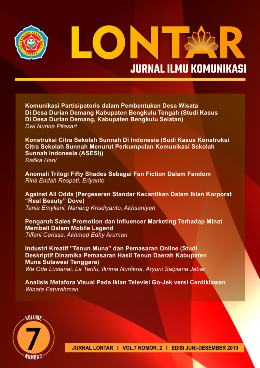AGAINST ALL ODDS (PERGESERAN STANDAR KECANTIKAN DALAM IKLAN KORPORAT “REAL BEAUTY†DOVE)
DOI:
https://doi.org/10.30656/lontar.v7i2.2046Keywords:
Shift, Beauty Standards, Wish Image, Public Relations Campaign, Corporate AdvertisingAbstract
This study looked at how the matching of signs related to the shift in standard of beauty incorporate advertising "Real Beauty" with Dove's wish image. In seeing this suitability, the author uses
the Semiotics method by Charles Sander Peirce to reveal the sign by grouping it into icons, indices, and
symbols found in corporate advertising. The shift related to beauty standards will be seen in the
corporate advertisements "Real Beauty, Meet Kylee" as the global version and "Real Beauty: Friends" as
the local version (Indonesia). The use of these two advertisements also aims to see whether Dove is
consistent in carrying out the "Real Beauty" campaign. The results of the sign analysis show that the
global version of the advertisement reflects a shift in the standard of beauty (a new definition of beauty),
the feminist movement, gender bias resistance and against social construction. Meanwhile, the sign
analysis on the local version of the ad is still fixated on traditional beauty standards, gender bias,
patriarchal culture, and the social construction that makes the ad "Real Beauty: Friends" does not reflect
the company's wish image and fails to maintain consistency in campaigning. Dove's failure to maintain
the consistency of the "Real Beauty" campaign with wish image can make Dove experience an identity
crisis that leads to a bad reputation or image for the company, such as the failure of the company's wish
image formation, and failure to reach marketing targets such as Dove expected.
Downloads
Published
Issue
Section
License
By submitting an article to the journal, the author(s) agree to transfer the published article's copyright to the journal, which will act as the publisher. This means the journal will have the right to publish the article in various forms, including reprints. The journal will maintain the publishing rights to the published articles.
In line with the license, authors and third parties (readers, researchers, and others) are allowed to share and adapt the material. In addition, the material must be given appropriate credit, provided with a link to the license, and indicated if changes were made. If authors remix, transform, or build upon the material, authors must distribute their contributions under the same license as the original.






